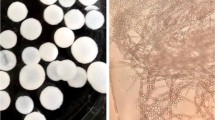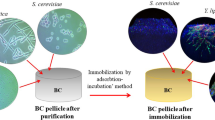Abstract
This paper focuses on the adhesion and biofilm formation potential of cellulolytic yeast Trichosporon cutaneum CCY 30-5-10 on solid cellophane from a novel perspective. First, physicochemical characterisation of the cells and carrier (cellophane) was performed to evaluate the effect of different culture media (complex vs mineral) on yeast cell adhesion. (Un)favourable adhesion conditions were predicted using the thermodynamic approach. Next, the ability of the cells to colonise the carrier under the above conditions was quantified and the biofilm structure was characterised using image analysis. The approaches described were found suitable to predict and experimentally verify favourable (cell-solid) adhesion, i.e. the hydrophobic and low electron-donor nature of cellophane together with hydrophobic cells (obtained when cultivated in a complex culture medium) were found to have a major impact in defining successful yeast adhesion with subsequent biofilm formation.
Similar content being viewed by others
References
Alonso, A. N., Pomposiello, P. J., & Leschine, S. B. (2008) Biofilm formation in the life cycle of the cellulolytic actinomycete Thermobifida fusca. Biofilms, 2008, 1–11. DOI: 10.1017/s1479050508002238.
Beyenal, H., Donovan, C., Lewandowski, Z., & Harkin, G. (2004) Three-dimensional biofilm structure quantification. Journal of Microbiological Methods, 59, 395–413. DOI: 10.1016/j.mimet.2004.08.003.
Bos, R., van der Mei, H. C., & Busscher, H. J. (1999) Physicochemistry of initial microbial adhesive interactions — its mechanisms and methods for study. FEMS Microbiology Reviews, 23, 179–230. DOI: 10.1111/j.1574-6976.1999.tb00396.x.
Bruinsma, G. M., van der Mei, H. C., & Busscher, H. (2001) Bacterial adhesion to surface hydrophilic and hydrophobic contact lenses. Biomaterials, 22, 3217–3224. DOI: 10.1016/s0142-9612(01)00159-4.
Cerca, N., Pier, G. B., Vilanova, M., Oliveira, R., & Azeredo, J. (2005) Quantitative analysis of adhesion and biofilm formation on hydrophilic and hydrophobic surfaces of clinical isolates of Staphylococcus epidermidis. Research of Microbiology, 156, 506–514. DOI: 10.1016/j.resmic.2005.01.007.
Cunliffe, D., Smart, C. A., Alexander, C., & Vulfson, E. N. (1999) Bacterial adhesion at synthetic surfaces. Applied and Environment Microbiology, 65, 4995–5002.
Dennis, C. (1972) Breakdown of cellulose by yeast species. Journal of General Microbiology, 71, 409–411. DOI: 10.1099/00221287-71-2-409.
Di Bonaventura, G., Pompilio, A., Picciani, C., Iezzi, M., D’Antonio, D., & Piccolomini, R. (2006) Biofilm formation by the emerging fungal pathogen Trichosporon asahii: Development, architecture, and antifungal resistance. Antimicrobial Agents and Chemotherapy, 50, 269–3276. DOI: 10.1128/aac.00556-06.
Dufrene, Y. F., & Rouxhet, P. G. (1996) X-ray photoelectron spectroscopy analysis of the surface composition of Azospirillum brasilense in relation to growth conditions. Colloids and Surfaces B: Biointerfaces, 7, 271–279. DOI: 10.1016/0927-7765(96)01295-7.
Dunne, W. M., Jr., (2002) Bacterial adhesion: Seen any good biofilms lately? Clinical Microbiology Reviews, 15, 155–166. DOI: 10.1128/cmr.2.155-166.2002.
Fonseca, F. L., Frases, S., Casadevall, A., Fischman-Gompertz, O., Nimrichter, L., & Rodrigues, M. L. (2009) Structural and functional properties of the Trichosporon asahii glucuronoxylomannan. Fungal Genetics and Biology, 46, 496–505. DOI: 10.1016/j.fgb.2009.03.003.
Georgieva, N., Yotova, L., Betcheva, R., Hadzhiyska, H., & Valtchev, I. (2006) Biobleaching of lignin in linen by degradation with Trichosporon cutaneum R57. Journal of the University of Chemical Technology and Metallurgy, Sofia, 41, 153–156.
Gusakov, A. V. (2011) Alternatives to Trichoderma reesei in biofuel production. Trends in Biotechnology, 29, 419–425. DOI: 10.1016/j.tibtech.2011.04.004.
Hamadi, F., & Latrache, H. (2008) Comparison of contact angle measurement and microbial adhesion to solvents for assaying electron donor-electron acceptor (acid-base) properties of bacterial surface. Colloids and Surfaces B: Biointerfaces, 65, 134–139. DOI: 10.1016/j.colsurfb.2008.03.010.
Hrmová, M., Biely, P., Vršanská, M., & Petráková, E. (1984) Induction of cellulose- and xylan-degrading enzyme complex in the yeast Trichosporon cutaneum. Archives of Microbiology, 138, 371–376. DOI: 10.1007/bf00410906.
Ichikawa, T., Nishikawa, A., Wada, H., Ikeda, R., & Shinoda, T. (2001) Structural studies of the antigen III cell wall polysaccharide of Trichosporon domesticum. Carbohydrate Research, 330, 495–503. DOI: 10.1016/s0008-6215(00)00325-6.
Jackson, G., Beyenal, H., Rees, W. M., & Lewandowski, Z. (2001) Growing reproducible biofilms with respect to structure and viable cell counts. Journal of Microbiological Methods, 47, 1–10. DOI: 10.1016/s0167-7012(01)00280-9.
Jana, T. K., Srivastava, A. K., Csery, K., & Arora, D. K. (2000) Influence of growth and environmental conditions on cell surface hydrophobicity of Pseudomonas fluorescens in non-specific adhesion. Canadian Journal of Microbiology, 46, 28–37. DOI: 10.1139/w99-104.
Kausar, H., Sariah, M., Mohd Saud, H., Zahangir Alam, M., & Razi Ismail, M. (2011) Isolation and screening of potential actinobacteria for rapid composting of rice straw. Biodegradation, 22, 367–375. DOI: 10.1007/s10532-010-9407-3.
Kuřec, M., & Brányik, T. (2011) The role of physicochemical interactions and FLO genes expression in the immobilization of industrially important yeasts by adhesion. Colloids and Surfaces B: Biointerfaces, 84, 491–497. DOI: 10.1016/j.colsurfb.2011.02.004.
Lewandowski, Z., & Beyenal, H. (2007) Fundamentals of biofilm research. Boca Raton, FL, USA: CRC Press.
Liu, Y., & Tay, J. H. (2002) The essential role of hydrodynamic shear force in the formation of biofilm and granular sludge. Water Research, 36, 1653–1665. DOI: 10.1016/s0043-1354(01)00379-7.
Lynd, L. R., Weimer, P. J., van Zyl, W. H., & Pretorius, I. S. (2002) Microbial cellulose utilization: Fundamentals and biotechnology. Microbiology and Molecular Biology Research, 66, 506–577. DOI: 10.1128/mmbr.66.3.506-577.2002.
Lynd, L. R., Weimer, P. J., Wolfaardt, G., & Zhang, Y. H. (2006) Cellulose hydrolysis by Clostridium thermocellum: A microbial perspective. In V. Uversky, & I. A. Kataeva (Eds.), Cellulosome: Molecular anatomy and physiology of proteinaceous machines (pp. 95–117). New York, NY, USA: Nova Science Publishers.
Mercier-Bonin, M., Ouazzani, K., Schmitz, P., & Lorthois, S. (2004) Study of bioadhesion on a flat plate with a yeast/glass model system. Journal of Colloid and Interface Science, 271, 342–350. DOI: 10.1016/j.jcis.2003.11.045.
Miron, J., & Forsberg, C. (1999) Characterization of cellulose-binding proteins that are involved in adhension mechanism of Fibrobacter intestinalis DR7. Applied Microbiology and Biotechnology, 51, 491–497. DOI: 10.1007/s002530051422.
Miron, J., Ben-Ghedalla, D., & Morrison, M. (2001) Invited review: Adhesion mechanisms of rumen cellulolytic bacteria. Journal of Dairy Science, 84, 1294–1309. DOI: 10.3168/jds.s0022-0302(01)70159-2.
Mohamed, N., Teeters, M.A., Patti, J.M., Höök, M., & Ross, J. M. (1999) Inhibition of Staphylococcus aureus adherence to collagen under dynamic conditions. Infection and Immunity, 67, 589–594.
Morrison, M., & Miron, J. (2000) Adhesion to cellulose by Ruminococcus albus: a combination of cellulosomes and and Pil-proteins? FEMS Microbiol Letters, 185, 109–115. DOI: 10.1111/j.1574-6968.2000.tb09047.x.
Paul, E., Ochoa, J. C., Pechaud, Y., Liu, Y., & Liné, A. (2012) Effect of shear stress and growth conditions on detachment and physical properties of biofilms. Water Research, 46, 5499–5508. DOI: 10.1016/j.watres.2012.07.029.
Rouxhet, P. G., Mozes, N., Dengis, P. B., Dufręne, Y. F., Gerin, P. A., & Genet, M. J. (1994) Application of x-ray photoelectron spectroscopy to microorganisms. Colloids and Surfaces B: Biointerfaces, 2, 347–369. DOI: 10.1016/0927-7765(94)80049-9.
Sadhu, S., & Maiti, T. K. (2013) Cellulase production by bacteria: A review. British Microbiology Research Journal, 3, 235–258. DOI: 10.9734/bmrj/2013/2367.
Sharma, P. K., & Rao, K. H. (2002) Analysis of different approaches for evaluation of surface energy of microbial cells by contact angle goniometry. Advances in Colloid and Interface Science, 98, 341–463. DOI: 10.1016/s0001-8686(02)00004-0.
Shi, Z. J., Luo, G. S., & Wang, G. J. (2012) Cellulomonas carbonis sp. nov., isolated from coal mine soil. International Journal of Systematic Evolutionary Microbiology, 62, 2004–2010. DOI: 10.1099/ijs.0.034934-0.
Shoham, Y., Lamed, R., & Bayer, E. A. (1999) The cellulosome concept as an efficient microbial strategy for the degradation of insoluble polysaccharides. Trends in Microbiology, 7, 275–281. DOI: 10.1016/s0966-842x(99)01533-4.
Sirmerova, M., Prochazkova, G., Siristova, L., Kolska, Z., & Branyik, T. (2013) Adhesion of Chlorella vulgaris to solid surfaces, as mediated by physicochemical interactions. Journal of Applied Phycology, 25, 1687–1695. DOI: 10.1007/s10811-013-0015-6.
Song, H. H., Clarke, W. P., & Blackall, L. L. (2005) Concurrent microscopic observations and activity measurements of cellulose hydrolyzing and methanogenic populations during the batch anaerobic digestion of crystalline cellulose. Biotechnology and Bioengineering, 91, 369–378. DOI: 10.1002/bit.20517.
Song, N., Cai, H. Y., Yan, Z. S., & Jiang, H. L. (2013) Cellulose degradation by one mesophilic strain Caulobacter sp. FMC1 under both aerobic and anaerobic conditions. Bioresource Technology, 131, 281–287. DOI: 10.1016/j.biortech.2013.01.003.
van Loosdrecht, M.C.M., Heijnen, J.J., Eberl, H., Kreft, J., & Picioreanu, C. (2002) Mathematical modelling of biofilm structures. Antonie van Leeuwenhoek, 81, 245–256. DOI: 10.1023/a:1020527020464.
van Oss, C. J. (1995) Hydrophobicity of biosurfaces — origin, quantitative determination and interaction energies. Colloids and Surfaces B: Biointerfaces, 5, 91–110. DOI: 10.1016/0927-7765(95)01217-7.
van Oss, C. J. (2003) Long-range and short-range mechanisms of hydrophobic attraction and hydrophilic repulsion in specific and aspecific interactions. Journal of Molecular Recognition, 16, 177–190. DOI: 10.1002/jmr.618.
Wang, Z. W., & Chen, S. L. (2009) Potential of biofilm-based biofuel production. Applied Microbiology and Biotechnology, 83, 1–18. DOI: 10.1007/s00253-009-1940-9.
Wang, Z. W., Lee, S. H., Elkins, J. G., & Morrell-Falvey, J. L. (2011) Spatial and temporal dynamics of cellulose degradation and biofilm formation by Caldicellulosiruptor obsidiansis and Clostridium thermocellum. AMB Express, 1, 30. DOI: 10.1186/2191-0855-1-30.
Wenzel, M., Schönig, I., Berchtold, M., Kämpfer, P., & König, H. (2002) Aerobic and facultatively anaerobic cellulolytic bacteria form the gut of the termite Zootermopsis angusticollis. Journal of Applied Microbiology, 92, 32–40. DOI: 10.1046/j.1365-2672.2002.01502.x.
Yang, X. M., Beyenal, H., Harkin, G., & Lewandowski, Z. (2000) Quantifying biofilm structure using image analysis. Journal of Microbiological Methods, 39, 109–119. DOI: 10.1016/s0167-7012(99)00097-4.
Young, J. M., Leschine, S. B., & Reguera, G. (2012) Reversible control of biofilm formation by Cellulomonas spp. in response to nitrogen availability. Environmental Microbiology, 14, 594–604. DOI: 10.1111/j.1462-2920.2011.02596.x.
Zhong, L. J., Pang, L. Q., Che, L. M., Wu, X. E., & Chen, X. D. (2013) Nafion coated stainless steel for anti-biofilm application. Colloids and Surfaces B: Biointerfaces, 111, 252–256. DOI: 10.1016/j.colsurfb.2013.05.039.
Author information
Authors and Affiliations
Corresponding author
Rights and permissions
About this article
Cite this article
Dostálková, J., Procházková, G., Jirků, V. et al. Physicochemical aspects of Trichosporon cutaneum CCY 30-5-10 adhesion and biofilm formation potential on cellophane. Chem. Pap. 69, 425–432 (2015). https://doi.org/10.1515/chempap-2015-0046
Received:
Revised:
Accepted:
Published:
Issue Date:
DOI: https://doi.org/10.1515/chempap-2015-0046




